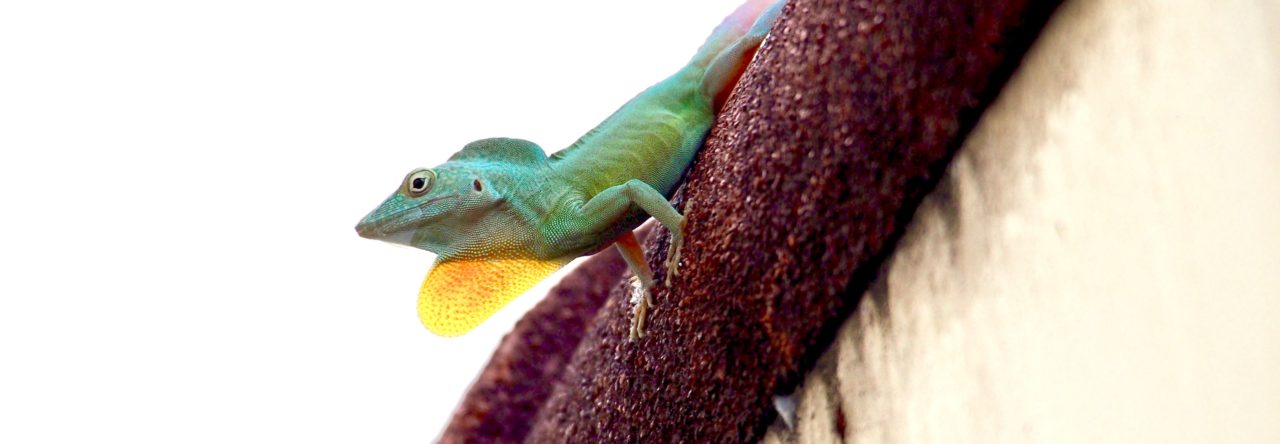 In anticipation of its sesquicentennial in 2017, The American Naturalist has solicited essays commenting on overlooked or underappreciated articles published in the journal during the past 150 years. In this month’s issue, Manuel Leal and I comment on a 1970 paper by Stan Rand and Ernest Williams on how differences among anole species in their dewlap and display behavior contain multiple signals for species-recognition. Several decades later, the importance of redundancy in communication signals has become an important area of research, but years before, Rand and Williams sketched out the important issues, as well as identifying some still-unresolved questions.
In anticipation of its sesquicentennial in 2017, The American Naturalist has solicited essays commenting on overlooked or underappreciated articles published in the journal during the past 150 years. In this month’s issue, Manuel Leal and I comment on a 1970 paper by Stan Rand and Ernest Williams on how differences among anole species in their dewlap and display behavior contain multiple signals for species-recognition. Several decades later, the importance of redundancy in communication signals has become an important area of research, but years before, Rand and Williams sketched out the important issues, as well as identifying some still-unresolved questions.
Here’s the introduction to our essay:
“Why are animal signals so complex? This question continues to attract the interest of behavioral and evolutionary ecologists. In this Countdown article, we revisit a littlea ppreciated article in The American Naturalist published in 1970: “ An Estimation of Redundancy and Information Content of Anole Dewlaps” by A. Stanley Rand and Ernest E. Williams. As part of this piece, Rand and Williams argued that signal complexity can be explained by redundancy, a mechanism by which multiple components of the signals have evolved to increase the probability of eliciting a response from an intended receiver. We highlight this work because it presents one of the earliest demonstrations of the potential benefits of applying information theory to animal communication. In addition, the study demonstrates the insights that can be gained by evaluating signal evolution at the level of the community. Even today, when both theoretical and empirical studies evaluating the potential forces leading to signal diversity have fl ourished, evaluations at the community level are extremely rare.
More generally, in the spirit of the American Society of Naturalists, we wish to emphasize that the perspicacity of Rand and Williams resulted from the fact that their ideas were ultimately derived from a deep understanding of the natural history of their study organism. In particular, Stan Rand spent substantial time in the fi eld observing lizards, including 10 months studying the ecology and social dynamics of the Jamaican lizard Anolis lineatopus. This study reported detailed observations of many aspects of behavior, including detailed descriptions of the signaling displays used during intra- and interspecific interactions (A. S. Rand, 1967, “ Ecology and Social Organization in the Iguanid Lizard Anolis lineatopus,” Proceedings of the United States National Museum 122:1– 79). It was this familiarity with what animals actually do in nature—when and where they do it, interacting in which ways with what other individuals—that formed the basis of the theoretical constructs put forth in Rand and Williams’ s article. At its core, Rand and Williams (1970) is an elegant illustration of the art of being a naturalist, demonstrating how an intimate knowledge of the organism can serve as the building blocks for the formulation of new conceptual approaches (see H. W. Greene, 2005, “ Organisms in Nature as a Central Focus for Biology,” Trends in Ecology and Evolution 20:23– 27, and references therein).”
You’ll have to read the essay to get the full details, but here’s the conclusion:
“By detailed field study of the morphology and behavior of sympatric lizards, Rand and Williams (1970) were able to outline the applicability of information theory to lizard signaling behavior and species recognition two decades before those ideas became widely accepted. Moreover, they proposed important hypotheses yet to be investigated. This article demonstrates the key role that natural history plays, and will continue to play, in the conceptual development of animal behavior, evolutionary biology, and many other fields. Although the tools available for technological advancement in these fields are unparalleled, Rand and Williams’ s work demonstrates that observing animals in the wild and developing an intimate knowledge of their ecology serves as the raw material for the development of new and exciting areas of research. Thus, as we move into new frontiers, the appreciation of natural history must be an integral component of our approach and should be encouraged to a new generation of behavioral and evolutionary ecologists.”
- Evolution in Real Time on Lizard Island - March 23, 2025
- Spider Snags Adult Anolis osa - March 22, 2025
- An Homage to the Green Anoles of New Orleans - March 21, 2025


Skip Lazell
Ah, remember it all well! I know EEW is long gone, but what became of my of old friend and colleague Stan Rand? Anyone know? Skip
Jonathan Losos
Alas, Stan, too, is no longer with us. He died in 2005. http://www.washingtonpost.com/wp-dyn/content/article/2005/11/26/AR2005112600999.html
Skip Lazell
Sad…. I guessed that. Thanks though Jonathan!